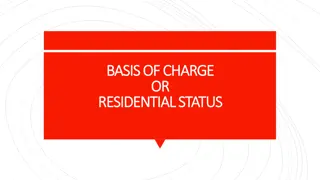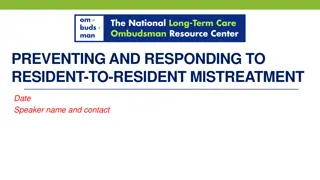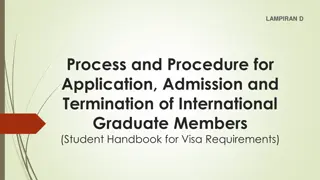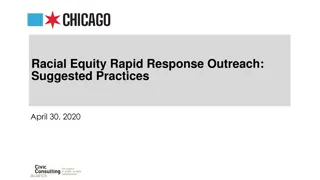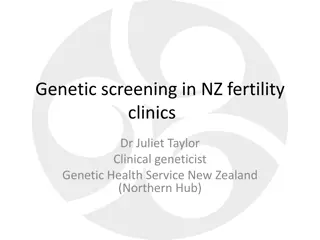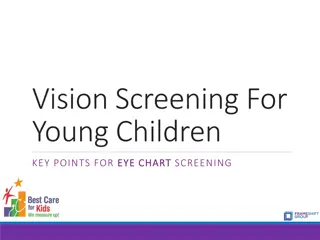Understanding PASRR: Pre-Admission Screening and Resident Review
PASRR is a federal mandate that requires screening individuals applying for or residing in Medicaid-certified skilled nursing facilities for major mental disorders, intellectual disabilities, and related conditions. Level I screenings using DMS-787 form aim to identify these conditions, with Level II evaluations conducted if needed. PASRR serves to ensure appropriate care and services for individuals in skilled nursing facilities.
Download Presentation

Please find below an Image/Link to download the presentation.
The content on the website is provided AS IS for your information and personal use only. It may not be sold, licensed, or shared on other websites without obtaining consent from the author. Download presentation by click this link. If you encounter any issues during the download, it is possible that the publisher has removed the file from their server.
E N D
Presentation Transcript
Preadmission Screening and Resident Review (PASRR) Instructions for DMS-787 Form Level I Screening for Suspected Major Mental Disorders and Intellectual Disabilities and Related Conditions For Training Purposes humanservices.arkansas.gov
Background on PASRR History and Purpose of PASRR Federal Statutes and Regulations Governing PASRR Level I Screens, Level II Evaluations, and Resident Reviews Positive vs. Negative Level I Screens When a Level II Evaluation is Required Layout of DMS-787 Form humanservices.arkansas.gov 2
History of Federal PASRR Requirements Federal statutes requiring preadmission screenings and resident reviews were enacted as part of the 1987 Omnibus Budget Reconciliation Act commonly called OBRA 87. (See Social Security Act section 1919(e)(7).) Final federal rules specifying PASRR requirements for states and Medicaid-certified skilled nursing facilities (SNFs) were published on November 30, 1992. Federal PASRR regulations have remained unchanged since 1992. (See 42 CFR 483.100 483.138.) humanservices.arkansas.gov 3
Purpose of PASRR PASRR is a federal mandate requiring the screening of all individuals applying for admission to or residing in a Medicaid-certified skilled nursing facility (SNF) to determine if they have: o A major mental disorder, o Intellectual disability or related condition (often referred to as a developmental disability), or o Combination of a major mental disorder and an intellectual disability or related condition. PASRR applies to all individuals applying for admission to a Medicaid-certified SNF, regardless of the payer source (e.g., Medicaid, Medicare, Medicare Advantage plan, commercial insurance, long-term care insurance, private pay, or other source). 1 humanservices.arkansas.gov 4
Purpose of PASRR Level I screens (using DMS-787 Form) are performed to help identify if an individual may have (a) a major mental condition and/or (b) an intellectual disability or related condition, based on federal criteria. 2 A Level II evaluation is required if the Level I screen indicates the individual has or is suspected of having a major mental condition, intellectual disability, and/or related condition, based on federal criteria. 3Bock Associates, DHS PASRR contractor, performs Level II evaluations. 4 Level II evaluations are performed to (a) confirm the individual s PASRR-relevant diagnoses; (b) identify the person s needs, if any, for specialized services that the SNF is not otherwise required to provide or arrange for; and (c) help determine if the SNF or another available care setting is appropriate given the person s major mental health conditions or intellectual disabilities or related conditions. For existing SNF residents, resident reviews are of all residents with mental illness or intellectual disability, regardless of whether they were first screened under the preadmission screening or annual resident review requirements. whenever the resident experiences a significant change in their physical or mental health. humanservices.arkansas.gov 5
Federal Statutes and Regulations Governing PASRR For your reference, federal PASRR requirements are found in: The federal statutory requirement for PASRR is found in section 1919(e)(7) of the Social Security Act (42 U.S.C. 1396r[e][7]). Federal regulations governing PASRR are under 42 CFR Part 483 Subpart C. Specifically, 42 CFR 483.100 438.138. humanservices.arkansas.gov 6
When is a Level II Evaluation Required When is a Level II Evaluation Required A Level II evaluation is required when a completed Level I screen (DMS-787 Form) indicates the individual: Meets at least one of two criteria on intellectual disabilities and related conditions defined in 42 CFR 483.102(b)(3). The criteria are described later in these instructions. Section II of the DMS-787 Form (page 1) provides the necessary questions for these two criteria. AND/OR Meets all four criteria on major mental conditions as defined in 42 CFR 483.102(b)(1). These criteria are described later in these instructions. Section III of the DMS-787 Form (pages 2-3) provides four questions, each corresponding to one of the four criteria. humanservices.arkansas.gov 7
Positive and Negative Level I Screens Positive and Negative Level I Screens Positive Level I Screen: Positive Level I Screen is when answers in the completed and signed DMS-787 Form indicate the individual meets or is suspected of meeting the federal criteria necessary for the individual for PASRR purposes to be considered to have: oA major mental disorder (see 42 CFR 483.102(b)(1); or oAn intellectual disability or related condition (see 42 CFR 483.102(b)(3); or oBoth a major mental disorder and an intellectual disability or related condition. All Positive Level I screens (DMS-787 Form) are referred for a federally mandated Level II evaluation. Level II evaluations are conducted by Bock Associates, the DHS PASRR contractor. Each Level II evaluation must be completed within 7-9 business days. Negative Level I Screen: Negative Level I Screen is when answers in the completed and signed DMS-787 Form indicate the individual does not meet and is not suspected of meeting federal PASRR criteria for (a) a major mental condition or (b) an intellectual disability or related condition. A Negative Level I screen does not require a Level II evaluation. humanservices.arkansas.gov 8
Layout of the DMS Layout of the DMS- -787 Form 787 Form SECTION I Page 1 Basic information on the applicant for SNF admission (or continued SNF stay) and the person completing the DMS-787 Form. Complete all fields, including Medicaid and Medicare ID numbers if applicable. SECTION II Page 1 Level I screening questions regarding intellectual and developmental disabilities (IDD) and related conditions. These questions are based on federal PASRR criteria in 42 CFR 483.102(b)(3). Answer each question. SECTION III Pages 2-3 Level I screening questions regarding major mental disorders. These questions are based on federal PASRR criteria in 42 CFR 483.102(b)(1). Answer each question. SECTION IV Page 3 Applicant s statement. Requires two signatures and dates of signing: signature of the applicant (or applicant s guardian or legal representative ), and signature of the person who completed the DMS-787. humanservices.arkansas.gov 9
Level I Screening for Suspected Intellectual Disabilities and Related Conditions Section II of DMS 787 Form Page 1 humanservices.arkansas.gov
Section II: Criteria for ID and Related Conditions Section II: Criteria for ID and Related Conditions For PASRR purposes, an individual is considered to have an intellectual disability (ID) if they meet at least one of two criteria. A Level II evaluation is required if one or both criteria are met (called a Positive Level I ID screen ). In summary: CRITERIA 1 Intellectual Disability: The individual has any level of intellectual disability (mild, moderate, severe, or profound) described in Intellectual Disability: Definition, Diagnosis, Classification, and Systems of Supports, 12th Edition, published by the American Association on Intellectual and Developmental Disabilities (AAIDD). CRITERIA 2 Related Condition: The individual has a severe, chronic disability due to a related condition that meets all the following: a. Related condition is attributable to cerebral palsy, epilepsy, or any other condition closely related to an intellectual disability (ID) due to impairment of general intellectual functioning or adaptive behavior, and the need for treatment or services is like that required for persons with an ID. Excludes mental illnesses and neurocognitive disorders; Related condition manifested before the person reached age 22; 5 b. Related condition Is likely to continue indefinitely; 6 and c. d. Related condition results in substantial functional limitations in three or more of these major life activities: self- care, understanding and use of language, learning, mobility, self-direction, and capacity for independent living. 7 humanservices.arkansas.gov 11
Section II: Intellectual Disabilities and Related Conditions (p. 1) 8 humanservices.arkansas.gov 12
Level I Screening for Suspected Major Mental Conditions Section III of DMS 787 Form Pages 2-3 humanservices.arkansas.gov
Section III: Criteria for Major Mental Disorder For purposes of PASRR, an individual is considered to have a major mental condition if they meet all four criteria required in 42 CFR 483.102(b)(1). A Level II evaluation is required if the completed Level I screen (DSM-787) shows all four criteria are met (called a Positive Level I MI screen ). Summary of the four criteria: Diagnosable Major Mental Disorder: The individual has one or more major mental disorders diagnosable under the Diagnostic and Statistical Manual of Mental Disorders, 3rd Edition Revised (DSM-III-R). 9 1 Level of Impairment: In the past 3-6 months, the major mental condition(s) has resulted in at least one of these three types of functional limitations in the individual s major life activities: 10 2 a. Interpersonal functioning. b. Concentration, persistence, and pace. c. Adaptation to change. Recent Treatment: In the past two years, due to the identified major mental condition(s), the individual: 3 a. Received psychiatric treatment more intensive than outpatient care more than once (e.g., partial hospitalization or inpatient hospitalization), and/or b. Had a significant disruption in normal living situation and received supportive services to maintain functioning at home or residential treatment environment or to address intervention by housing or law enforcement officials.11 Major Neurocognitive Disorder: The individual does not have a primary diagnosis of a Major Neurocognitive Disorder (MNCD), formerly called Dementia, including Alzheimer s and related conditions. 12 4 humanservices.arkansas.gov 14
Section III: Question 1 on Diagnosable Major Mental Disorders 13 humanservices.arkansas.gov 15
Section III: List of Major Mental Disorders for Question 1 14 Major Mental Disorder Specific DSM-III-R Diagnosis If Disorder is a Category or Cluster Schizophrenia All diagnosis types under Schizophrenia Schizoaffective Disorder All diagnosis types under Schizoaffective Disorder Somatoform Disorder All diagnosis types under Somatoform Disorder Bipolar Disorder Bipolar Type I or Bipolar Type II Major Depression Major Depression Only Panic Disorder, Generalized Anxiety Disorder, Agoraphobia, or Post-Traumatic Stress Disorder (i.e., Cluster A anxiety disorders) Panic or other Severe Anxiety Disorder Paranoid Personality Disorder, Schizoid Personality Disorder, or Schizotypal Personality Disorder Severe Personality Disorder Other Psychotic Disorder Brief Reactive Psychosis, Induced Psychotic Disorder, or Atypical Psychosis From the DSM-III-R specify the name of the diagnosis in the space provided in DSM-787 Section III, Question 1 answer. Other Major Mental Disorder with Severe Impairments or Risk of Chronic Disability Only for DSM-III-R recognized severe mental illness(s) not covered by the major mental disorders listed above or any specific diagnoses the DSM-III-R lists under any of those major mental disorders. humanservices.arkansas.gov 16
Key Considerations in Identifying Major Mental Disorders 1. Major Mental Conditions for PASRR Purposes: Only certain mental health diagnoses are considered major mental disorders for purposes of PASRR and federal regulations. The specific diagnoses that are considered major mental disorders for PASRR purposes (Level I screens and Level II evaluations) are listed in the preceding slide. 2. Major Mental Condition is Diagnosed or Diagnosable: The Level I screen for major mental disorders is intended to identify whether the individual may have a major mental disorder(s). A specific major mental disorder may be identified for an individual because the condition is either: a. Diagnosed: The individual has a current or recent diagnosis documented in the medical record, OR b. Diagnosable: The individual s current or recent symptoms and behaviors are consistent with the applicable DMS-III-R diagnostic criteria for the condition and are documented in the medical record. Continued Next Page humanservices.arkansas.gov 17
Key Considerations in Identifying Major Mental Disorders 3. Diagnostic Criteria Based on DSM-II-R: Diagnostic criteria for major mental conditions are based on the Diagnostic and Statistical Manual of Mental Disorders, Third Edition Revised (DSM-III-R), published by the American Psychiatric Association. 4. Neurocognitive Disorders, Physical Health Conditions, and Non-Severe Mental Health Conditions: In identifying whether an individual may have a major mental condition, exclude conditions, symptoms, behaviors, and cognitive or functional impairments that are caused by a diagnosed: a. Major or minor neurocognitive disorder, with or without behavioral disturbances. Major neurocognitive disorder (MNCD), the new clinical term for dementia, includes Alzheimer s disease, Lewy body disease, subcortical vascular disease, traumatic brain injury, Parkinson s disease, and related conditions. Major and minor neurocognitive conditions are not mental illnesses. However, common neurocognitive disorder symptoms include anxiety, depression, elation, agitation, confusion, hallucinations, and delusions. b. Physical health condition. c. Non-severe mental health condition. humanservices.arkansas.gov 18
Section III: Question 2 on Level of Impairment Interpersonal Functioning: The individual has serious difficulty interacting appropriately and communicating effectively with other persons, and has a possible history of altercations, evictions, firing, fear of strangers, avoidance of interpersonal relationships, and social isolation. 15 Concentration, Persistence, and Pace: The individual has serious difficulty in sustaining focused attention for a long enough period to permit the completion of tasks commonly found in work settings or in work-like structured activities occurring in school or home settings, manifests difficulties in concentration, inability to complete simple tasks within an established time period, makes frequent errors, or requires assistance in the completion of these tasks. 16 Adaption to Change: The individual has serious difficulty in adapting to typical changes in circumstances associated with work, school, family, or social interaction, manifests agitation, exacerbated signs and symptoms associated with the illness, or withdrawal from the situation, or requires intervention by the mental health or judicial system. 17 humanservices.arkansas.gov 19
Section III: Question 3 on Recent Treatment History (page 2) 18 Questions 2 and 3 are dependent on the individual having a diagnosed or diagnosable major mental condition identified in Question 1 of Section III. Therefore, answer N/A to both Questions 2 and 3 if the answer to Question 1 is NO. humanservices.arkansas.gov 20
Section III: Question 4 on Major Neurocognitive Disorder (p. 3) humanservices.arkansas.gov 21
Section IV: Applicants Statement (Page 3) In Section IV on page 3: Secure the necessary signature from the applicant or their legal representative or guardian. The person who completed the DMS-787 Form (Level I screen) needs to sign where indicated. Ensure both signature lines are dated. humanservices.arkansas.gov 22
Double Checks and Next Steps When DMS- 787 is Completed 1. Double-Check That: All questions in Sections I, II, and III are answered. If the DMS-787 is not completely filled out, or has inaccuracies or discrepancies, your review may be delayed as Bock or DPSQA may send the information back to you for review or revision. If information on the new DMS-787 conflicts with information on a previous DMS-787 form, Bock will contact you to inform you of the differences and work with you to ensure the correct information is on the form. The applicant s full name appears at the top of pages 2 and 3. Section IV (Applicant s Statement) has the two required signatures with dates. 2. DMS-780 Dementia Diagnosis Substantiation Form: If the answer to Question 4 in Section III (Major Neurocognitive Disorder) is YES, submit a completed DMS-780 (Dementia Diagnosis Substantiation Form) with the completed and signed DMS-787 Form. 3. Submit the Completed and Signed DMS-787 Form and DMS-780 Form (if required) to Bock Associates, if the Level I screen indicates the need for a Level II: Fax number is 501-374-254119 Email is bock.arkansas@bock-associates.com Please confirm that the fax transmission was successful. If practicable, retain the fax confirmation for the file. 4. Do not use the previous DMS-787 Form. If you do, Bock will send it back to you and direct you to use the new DMS-787 Form. This may result in a delay. humanservices.arkansas.gov 23
Next Steps When DMS-787 is Completed- Where to Send the Forms Forms DPSQA Bock Facility Retain Copy Time Frame Yes Yes, if failed the Level I Yes Within 48 hours of admission 787 Pre- Admission Level 1 Screening Yes No Yes Within 48 hours of admission 703 Medical Eligibility Yes, if applicable Yes, if applicable Yes Within 48 hours of admission 780 Dementia Diagnosis Yes N/A Yes N/A PASRR Approval Letter humanservices.arkansas.gov 24
End Notes 1. See 42 C.F.R. 483.102. 2. See 42 C.F.R. 483.128. 3. See 42 C.F.R. 483.128. 4. See Procedures for Determination of Medical Need for Nursing Home Services II(A)(4). 5. See 42 C.F.R. 483.126. 6. See 42 C.F.R. 435.1010. 7. See 42 C.F.R. 435.1010. 8. See form for relevant citations. 9. See 42 C.F.R. 483.102. 10. See 42 C.F.R. 483.102. 11. See 42 C.F.R. 483.102. 12. See 42 C.F.R. 483.102. 13. See form for relevant citations. 14. See 42 C.F.R. 483.102. 15. See 42 C.F.R. 483.102. 16. See 42 C.F.R. 483.102. 17. See 42 C.F.R. 483.102. 18. See form for relevant citations. 19. See Procedures for Determination of Medical Need for Nursing Home Services II(A)(4). 25
Questions? humanservices.arkansas.gov 26
Find Us On @ArkDHS @arkansasdhs @ARHumanServices ARHumanServices Contact Information Martina Smith, JD Director of Division of Provider Services and Quality Assurance Martina.Smith@dhs.Arkansas.gov (501) 396-6165 humanservices.arkansas.gov 27
Title Line We Care. We Act. We Change Lives. humanservices.arkansas.gov











